There’s something to be said about the feeling of power one gets when cruising down a highway from a height position.
No, we aren’t discussing the thrill of flying an airplane or piloting a massive ship.
Instead, let’s bring our wheels back to the ground and consider a common, everyday vehicle that has, over the years, found an increasing number of enthusiasts – a class of vehicle that, despite its size and imposing stature, tends to put its drivers at ease, rather than make them nervous.
SUVs offer elevated command seating, providing better visibility of the road and surroundings. This height advantage makes it easier to anticipate and react to traffic conditions. Additionally, modern SUVs come with advanced driver-assist technologies, making them easier and safer to drive.

It’s a conversation about comfort and control in a vehicle and the unexpected ease that some drivers find when they climb into the driver’s seat of this widely popular automotive giant.
Related:
- Difference Between a KUV and an SUV? Deciphering the Intricacies of Utility Vehicle Classification
- Why Do People Call SUVs Trucks? Unraveling the Semantic Mysteries of Automotive Terminology
- Difference Between a Van and an SUV? Breaking Down the Essentials of Vehicle Design and Functionality
The Rise of SUV Popularity: A Historical Overview
In the annals of automotive history, the ascent of the Sport Utility Vehicle (SUV) is a fascinating tale that intricately weaves threads of shifting consumer preferences, technological advancements, and changes in socio-economic landscapes.
Born out of a demand for vehicles that could handle rough terrains while offering ample space for passengers and cargo, the first SUVs were nothing more than trucks with enclosed cargo areas. Over the years, they evolved into the family-friendly, comfortable, and commanding vehicles we see today.
From the Jeep Wagoneer in the 1960s to the Ford Explorer in the 1990s, SUVs have gradually earned their place in the hearts and garages of consumers worldwide.
What began as an anomaly on the roads and a symbol of off-road ruggedness became an epitome of luxury and comfort, breaking the stereotypes of automotive design.
The allure of SUVs expanded beyond the realm of the adventurous and into the urban, transforming market dynamics.
As technology advanced, SUVs began incorporating features that made them as comfortable and easy to drive as cars while maintaining their inherent advantages – a key factor behind their enduring popularity.
Defining Elevated Command Seating: The SUV Advantage
Elevated command seating is a term used to describe the raised driving position typically found in Sport Utility Vehicles (SUVs).
This seating design allows drivers to sit higher off the ground than most other vehicles, including sedans and hatchbacks.
The vantage point this creates, akin to being in command of your path, is where the term derives its name.
This seating style offers multiple advantages. For one, it provides drivers with a better, more encompassing view of the road and their surroundings, which is particularly beneficial in heavy traffic, at intersections, and while parking.
It also allows for easier ingress and egress, particularly for older adults or those with mobility issues.
Moreover, elevated command seating can instill a sense of safety and confidence, as the driver feels more in control due to their elevated perspective.
From navigating through crowded city streets to exploring off-road trails, this higher, commanding position, accompanied by the robust structure of an SUV, enhances the overall driving experience.
Enhanced Visibility: Seeing Beyond the Immediate

Visibility is a crucial element in the sphere of driving. It influences our perception of the road, our response to potential hazards, and ultimately, our ability to operate a vehicle safely.
With their lower seating position, standard passenger cars often limit the driver’s field of view, creating blind spots that could lead to accidents.
This is where the role of elevated command seating in an SUV steps in to alter the game.
When positioned higher off the ground, drivers are afforded a wider and more comprehensive view of their surroundings.
This elevated perspective allows for better anticipation of the road ahead, the movements of other drivers, and potential hazards.
It aids in spotting obstacles that would otherwise be concealed by the car’s hood or obstructed by other vehicles on the road.
Improved visibility is not just beneficial while driving on highways or open roads. In congested urban environments, it gives drivers a distinct advantage in seeing over the tops of smaller cars, enabling them to anticipate and react to traffic situations more effectively.
Whether spotting a pedestrian crossing the road ahead or noticing a car pulling out of a side street, the enhanced visibility from an SUV can significantly contribute to a safer, less stressful driving experience.
Handling and Control in SUVs: A New Paradigm
While the larger size and higher center of gravity of SUVs once presented challenges for handling and control, modern engineering and technology have dramatically improved these aspects.
Today’s SUVs aren’t just about commanding road presence and increased space; they also offer impressive maneuverability and control that was once reserved for smaller, nimbler vehicles.
Vehicle manufacturers have made significant strides in enhancing the driving dynamics of SUVs. Advanced suspension systems, stability control, and precision steering have considerably improved their handling characteristics.
This makes them more responsive and easier to control at high speeds and when navigating tight city streets.
In addition, many SUVs now come with intelligent all-wheel-drive systems. These systems can adapt to different road conditions, automatically distributing power to the wheels that need it most.
This feature enhances traction on slippery or uneven surfaces and improves overall stability, making the vehicle easier to handle.
Furthermore, many SUVs are equipped with hill descent control and electronic stability control, which assist the driver in maintaining control in challenging situations.
Combined with their innate ability to tackle rough terrain due to higher ground clearance, these features make SUVs versatile vehicles that offer an assured drive, whether you’re navigating bustling city streets or exploring off-road trails.
Driving Comfort: The Unspoken SUV Benefit
Comfort is an aspect of the driving experience often overshadowed by performance, safety, and aesthetics discussions.
However, in SUVs, comfort is a crucial element that can significantly enhance the driving experience, and it extends far beyond just the quality of the seat cushions or the smoothness of the ride.
The design and ergonomics of SUVs, shaped by the philosophy of elevated command seating, inherently contribute to the overall comfort level for both the driver and the passengers.
The higher seating position in SUVs provides a commanding view of the road and a more natural, upright seating posture. This can be particularly beneficial during long drives, reducing fatigue and discomfort.
Furthermore, getting in and out of an SUV is generally easier due to the higher seat height, which can be a significant advantage for taller individuals, older adults, or anyone with mobility issues.
Other comfort-enhancing aspects of SUVs include:
- Spacious interiors: SUVs typically offer more headroom, legroom, and shoulder room than most passenger cars, providing a more comfortable environment for drivers and passengers.
- Versatile seating: Many SUVs feature flexible seating arrangements that can be adjusted or removed to accommodate passengers, cargo, or a mix of both.
- Noise reduction: SUVs often use advanced noise-dampening technologies, offering a quieter, more relaxed driving experience.
- High-quality suspension systems can absorb road bumps and imperfections effectively, providing a smoother, more comfortable ride.
- Climate control systems: Modern SUVs often feature advanced climate control systems, ensuring comfort for all occupants regardless of outside weather conditions.
Safety Factors: How SUVs Stack Up
Safety is a primary consideration for many when choosing a vehicle, and SUVs have come a long way.
While their size and the elevated seating position can offer a perceived sense of safety, the combination of design elements, advanced technology, and rigorous safety standards make modern SUVs a viable option for those prioritizing safety.
Historically, the larger mass of an SUV could potentially offer more protection in a collision than a smaller car, given basic physics.
However, this advantage was offset by a higher risk of rollovers due to a higher center of gravity.
Automakers have recently addressed this issue by implementing advanced stability control systems and designing lower, wider stances to reduce rollover risks.
Today, many SUVs have a wealth of safety features to prevent accidents and protect occupants in case of a crash. These include:
- Advanced driver-assistance systems (ADAS): These include adaptive cruise control, lane-keeping assist, blind spot detection, and forward collision warning, all designed to alert the driver to potential hazards and even intervene when necessary.
- Structural safety: SUVs often have robust structures, including reinforced passenger compartments and crumple zones that absorb energy during a crash, protecting the occupants.
- Airbags: Modern SUVs have front and side-curtain airbags that provide additional protection in case of a side impact or rollover.
- High-tech braking systems: Anti-lock braking systems (ABS), electronic brake-force distribution (EBD), and brake assist (BA) all contribute to better control of the vehicle during emergency braking situations.
While SUVs offer numerous safety advantages, it’s essential to remember that safe driving habits are crucial in maintaining safety on the road. Despite a vehicle’s advanced safety features, they are ultimately tools to aid, not replace, a diligent and attentive driver.
Closing Thoughts
In the world of driving, there’s a certain allure to sitting behind the wheel of an SUV, and it’s not just about the imposing size and rugged appearance.
It’s about the unique sensation of power and control that comes from the elevated command seating these vehicles offer.
As we wrap up our exploration of the advantages of elevated command seating in SUVs, it’s evident that there’s more to this feature than meets the eye.
The popularity of SUVs isn’t merely a coincidence; it’s a result of decades of evolution and innovation in response to shifting consumer preferences and technological advancements.
From their humble beginnings as off-road workhorses to their current status as symbols of comfort and versatility, SUVs have rewritten the rules of the automotive world.
At the heart of the SUV’s appeal is the concept of elevated command seating. This design element, which places the driver higher off the ground, provides tangible benefits that go beyond aesthetics.
It significantly improves visibility, offering drivers a broader and more comprehensive view of their surroundings. This heightened perspective enhances safety by allowing for better anticipation of the road ahead and potential hazards, whether on crowded city streets or open highways.
Moreover, the advantages of elevated command seating extend to ease of ingress and egress, reducing the strain on drivers and passengers alike.
The sense of control and security derived from this vantage point can boost confidence on the road, transforming the driving experience from a task to a pleasure.
In today’s SUVs, comfort and handling are top priorities. Advanced engineering and technology have eliminated many of the handling challenges traditionally associated with larger vehicles.
From responsive steering to all-wheel-drive systems that adapt to changing road conditions, modern SUVs offer a level of control and maneuverability that rivals smaller cars.
Comfort is another pillar of the SUV experience. Spacious interiors, versatile seating arrangements, noise reduction technologies, and advanced climate control systems all contribute to making long drives more enjoyable.
Whether you’re cruising down the highway or navigating city traffic, SUVs prioritize your comfort.
Safety, a paramount concern for drivers, is another area where SUVs excel. Their robust structures, complemented by a host of advanced safety features like adaptive cruise control and comprehensive airbag systems, offer protection in various driving scenarios.
While an SUV’s size can provide a measure of safety, it’s these integrated technologies that truly elevate their safety profile.
In conclusion, driving an SUV isn’t just about transportation; it’s about an experience marked by comfort, control, and safety. Elevated command seating, a defining feature of SUVs, plays a pivotal role in enhancing this experience.
So, the next time you find yourself behind the wheel of an SUV, take a moment to appreciate the unique perspective it offers and the multitude of advantages that come with it. It’s more than just a seat; it’s your elevated command over the road.



